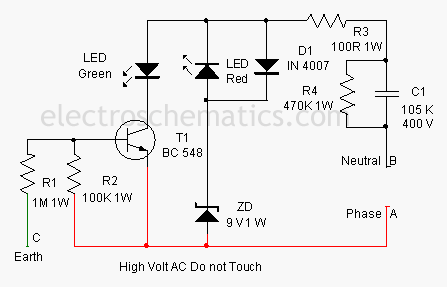Earth Fault Indicator circuit
This circuit indicates the integrity of wiring connections. It
shows all the mains connections – Phase, Neutral and Earth connections –
are intact or not. The circuit is too small and can be housed in a
three pin plug case.
Earth Fault Indication Circuit Diagram

The circuit is directly connected to mains to monitor the status of the
connections. Earth connection is a must in domestic wiring to bleed
current to the earth if the metal body of a device is accidentally
touched with the phase line. This circuit indicates
1. Red and Green LEDs ON Phase, Neutral and Earth OK
2. Red and Green LEDs OFF Phase or Neutral Break / Power failure
3. Red LED ON Phase and Neutral OK
3. Green LED OFF Earth line break
The circuit gets power supply through C1 and R3. AC Capacitor C1
reduces the high volt AC to a safer level through capacitive rectance.
Resistor R3 limits the inrush current and R4 gives discharge path for
the stored current in C1 when the circuit is unplugged. Zener diode ZD
regulates the voltage to a safer level to protect T1 when it is off.
Voltage across ZD will be a square wave by the working of C1 and the
voltage level depends on the breakdown value of zener (9 volts). When a
potential of 230 volt is present between the phase and neutral lines, T1
turns on during the negative half cycle of AC and Green LED lights
indicating that Earth connection is intact. This is because the base of
T1 will be biased by the potential difference between the phase line and
earth. If the earth connection is not intact, T1 will not get base bias
and it remains off. Red LED lights during the positive half cycle of AC
due to the potential difference between the phase and neutral lines.
Enclose the circuit in a 3 pin plug and connect points A, B and C to the
phase, neutral and earth pins respectively. Plug it into the 3 pin
socket to test the wiring.




